Home>Help and training>How to use the catalogue?
How to use the catalogue?
Below, we take you step-by-step through the essentials of searching our catalogue.
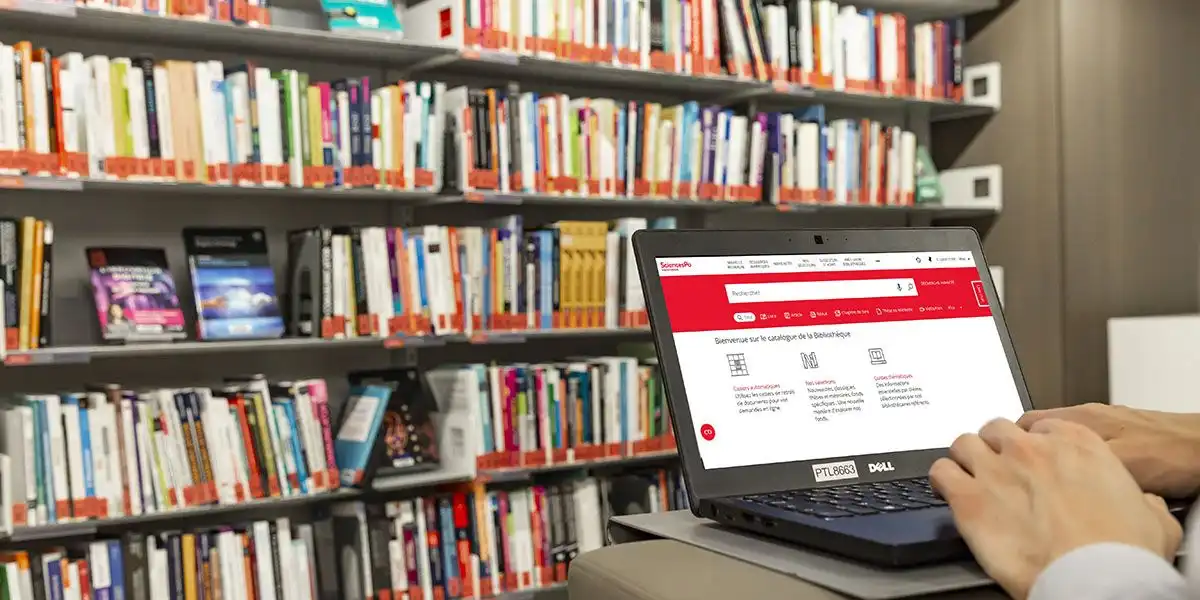
Contents
- The scope of the catalogue
- Discover the interface
- Perform a basic search
- Perform an advanced search
- View the results page
- Access a print item in the reading room
- Make an online request (closed stack items, shuttle, regional campus loan, reservation)
- Access an item online
- Manage your “favourites”
- Saving your searches
- Your library account
- Use the AI search assistant in the catalogue
The scope of the catalogue
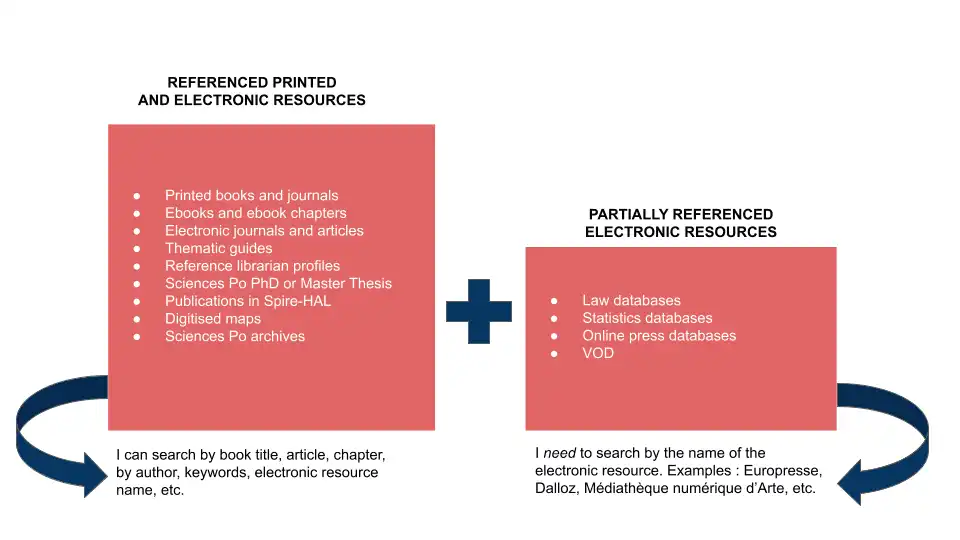
The library's entire print collection (all campuses) is searchable. This includes:
- Printed books and journals
- Sciences Po Phd and Master Thesis
- Sciences Po Archives
The majority of electronic resources are searchable, this includes :
- Ebooks and ebooks chapters
- Electronic journals and articles
- Thematic guides
- Reference librarian profiles
- Sciences Po Phd and Master Thesis
- Publications in Spire-HAL
- Digitised maps
- Sciences Po Archives
There are some limitations, depending on the category of digital resource:
- legal and press databases are poorly referenced; you will find magazine, newspaper and book titles, but you won't find the articles in these databases via the simple catalog search. In this case, turn to the catalogue's electronic resources page.
- The content of statistical databases is not referenced at all. It's best to search these databases directly.
- Streaming videos from our subscription to the Arte Digital Media Library are not referenced in the catalogue. You can search this database directly here.
Discover the interface
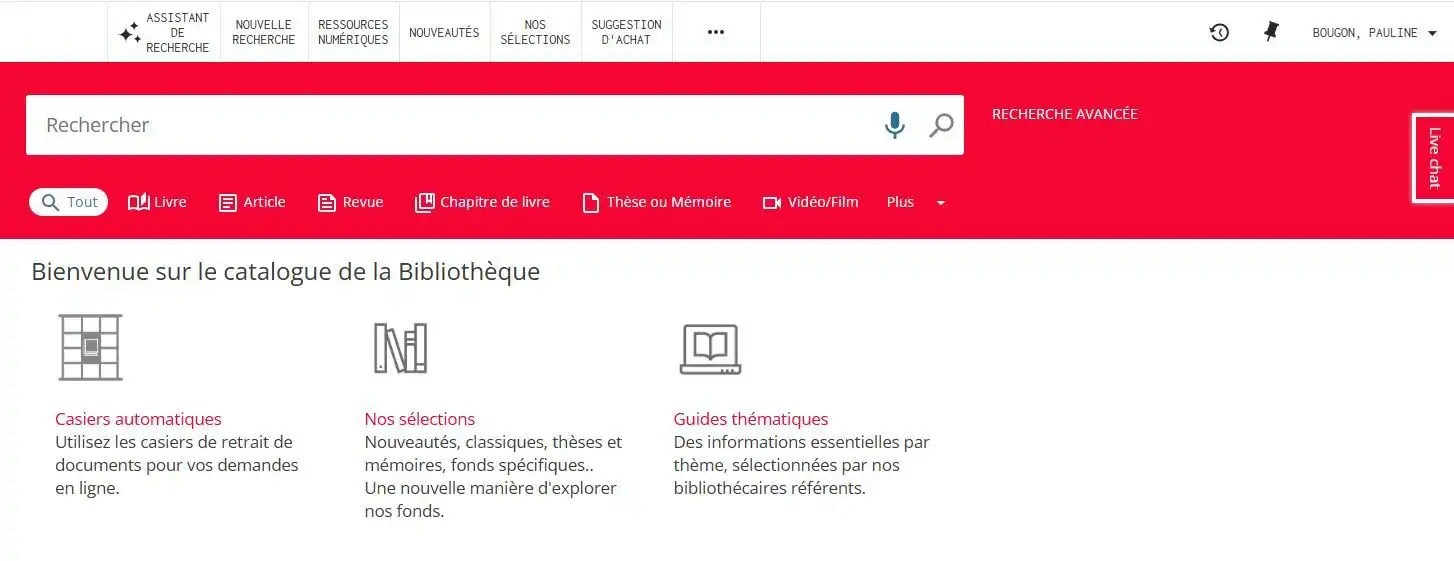
The home page is organised around the search engine. It offers shortcuts that you can access from any page of the catalogue:
- New Search
- Electronic Resources
- Inter Library Loan
- Purchase Request
- Help
Services buttons:
- Go to search history
- Go to my favourites
- Sign in
- Menu
- Contact a librarian
It is important to sign in early on in your search: some of the content and services offered will only be visible once you are signed in.
As with all Sciences Po services, identify yourself using the format:
username: firstname.lastname // Sciences Po password
If you have a problem with your identifiers, click here.
If you are on a public computer, remember to log out before leaving the catalogue.
Perform a basic search
It is important to sign in early on in your search: some of the content and services offered will only be visible once you are signed in.

Step 1: Enter your search terms in the search box.
Step 2: Select a search profile:
- by default, this is set to Everything: the search is performed on all the resources covered by the catalogue (print and electronic);
- Among journals or Among books: these two profiles limit the results according to item type, either journals or books.
Item type does not mean format! An item might be a journal or a book (item type) in either print or electronic format.
- By campus: this profile limits the results to university-wide e-resources and print items kept on the selected campus. For example, all e-resources BUT only the print collection of the Poitiers library.
- Pour désactiver le filtre, cliquer sur Tout.
Step 3: Loupe button or [Enter]
There are various ways to refine your search:
- quotation marks for an exact phrase
- the Boolean operators AND, OR, and NOT (always in capital letters), with brackets to group terms where appropriate
- wildcard: ? (substitute one character)
- truncation: * (substitute several characters)
Perform an advanced search
It is important to sign in early on in your search: some of the content and services offered will only be visible once you are signed in.
Step 1: Click Advanced Search:
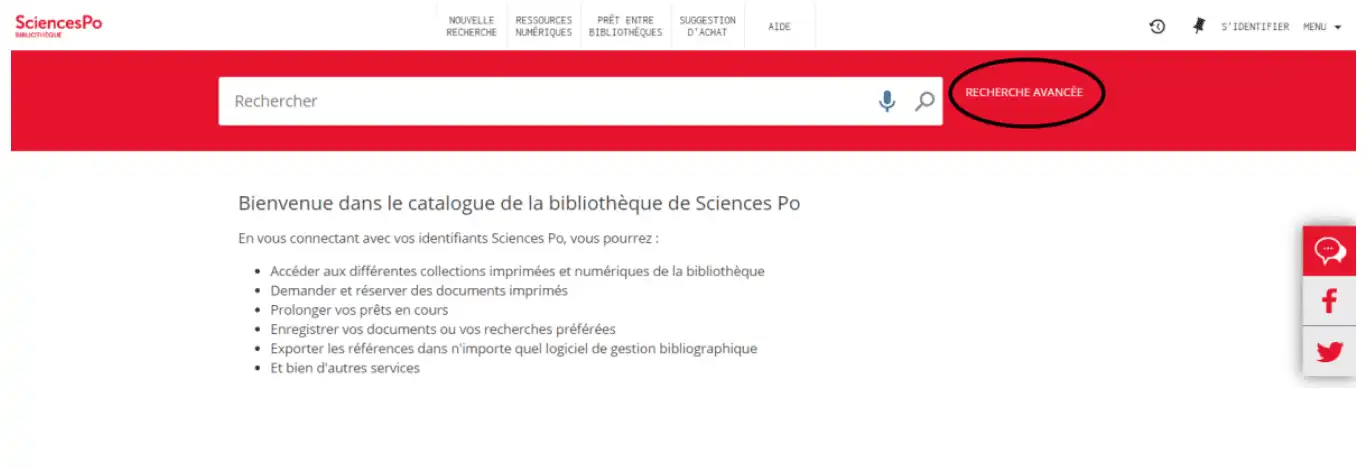
Step 2: The advanced search screen is displayed:
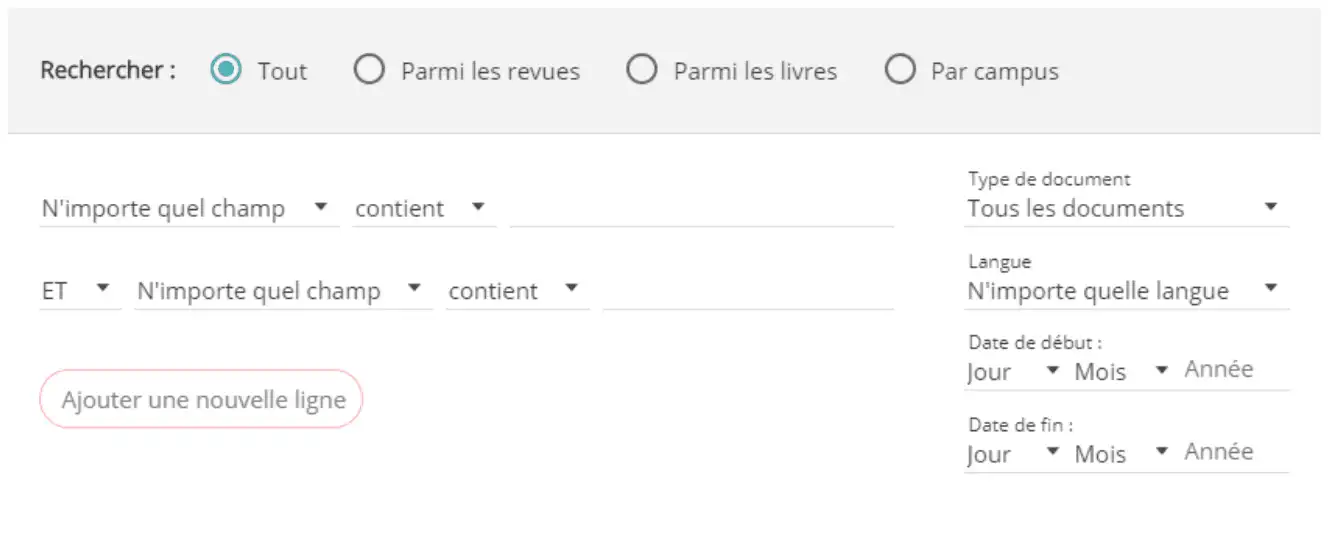
You can now search in a specific field and/or combine different fields:
- Any field
- Title
- Author/Creator
- Subject (subject index)
- Call Number
- ISBN
- ISSN
- Table of Contents
- Description
- Place (geographic index)
Your advanced search can use search terms in conjunction with Boolean operators to combine the different fields, and limit the search to a particular profile (Among journals, Among books, By campus).
View the results page
It is important to sign in early on in your search: some of the content and services offered will only be visible once you are signed in.
The results appear as a list.
Suggestions may appear above the list of results: the subject librarian, the subject guide, and databases related to your search.
- Order of results:
- Sort by Relevance: this is the default order. Results defined by the algorithm as being closest to what you are looking for
- Sort by Date
- Sort by Title (alphabetical order)
- Sort by Author (alphabetical order)
- On the right, you can filter your results by adding or excluding one or more details.

You can filter results using various criteria: availability, library, location, resource type, publication date, author/creator, subject, language, and place:
- the Availability filter lets you limit the search to electronic or print items;
- the Library filter lets you restrict you search to a geographic area:
- Paris Bibliothèque limits the results to all items in the libraries on the Paris campus AND the closed stacks located on the campus
- Reims Bibliothèque limits the results to items present in Reims
- Magasins distants corresponds to items stored in the stacks outside Paris.
When you filter the results by Library, electronic resources are excluded! It’s better to use the By Campus search profile if you want to get results from a given library AND e-resource results.
- the Location filter lets you limit your search to a specific reading room, stacks, building, etc.
- On the results page, several actions are possible:
- Red Pin icon/ Add this item: lets you save items in favourites;
- Quote marks icon/Citation: you can collect citations in various bibliographic styles;
- Double ring icon/ Permalink: get the direct link to the record;
- Mail icon/Email: send the reference by email (only one recipient at a time, for the moment);
- File icon / Export RIS: export the reference in RIS format to add it to your reference management software.
N.B. If you are using Zotero, the Zotero plugin in your browser will automatically retrieve the bibliographic reference without having to use this Export function.
Each of these actions can be performed for a single item or for a series of items selected from the results list.
- If the library has several editions of the same item, they may be grouped together in the same result, which will specify X versions found. See all versions. Click on it to see all available versions.

Access a print item in the reading room
It is important to sign in early on in your search: some of the content and services offered will only be visible once you are signed in.
Following a simple or advanced search, click on a result to see its full description or record.
The record contains three main sections:
- the location/access section

- the item’s bibliographic record (or details)
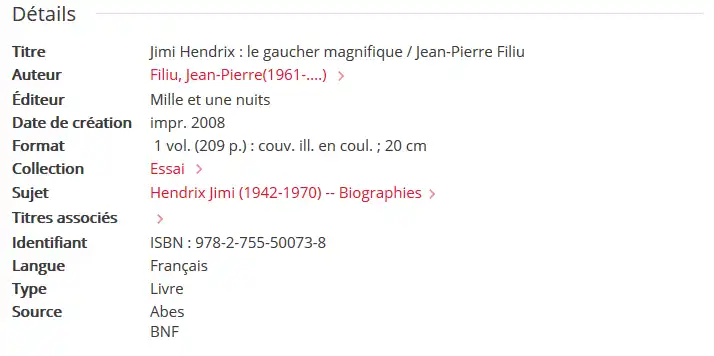
- the Send to section

The item access section gives you the three pieces of information you need to retrieve your item:

- item availability (available);
- its location (Library at 27 Rue Saint-Guillaume, 2nd floor) ;
- the call number (336.02-CAB-2011).
So now you can find it in the reading room and borrow it from the loan desk or from the self-service loan machines.
Make an online request (closed stack items, shuttle, regional campus loan, reservation)
It is important to sign in early on in your search: some of the content and services offered will only be visible once you are signed in.
Following a simple or advanced search, click on a result to see its full description.
The record contains three main sections:
- the location/access section
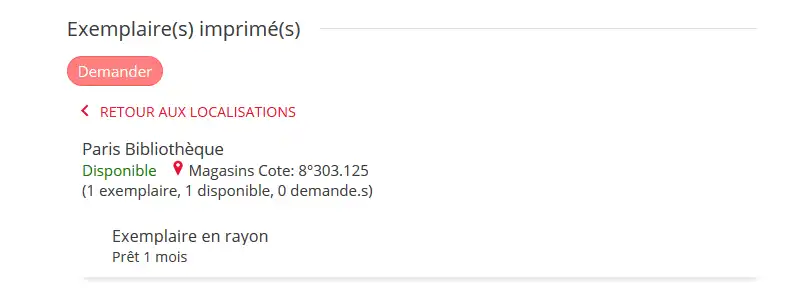
- the item’s bibliographic record (or details)
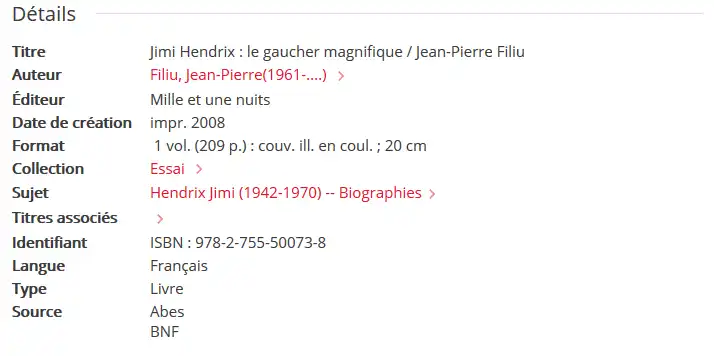
- the Send to section

The Request button lets you:
- request or reserve items from the closed stacks, which can be borrowed or used on site;
- use the shuttle or regional campus loan service (depending on your access rights and your home campus);
- reserve items from the reading rooms if they are out on loan.
Step 1: When you have a record open, click the Request button:
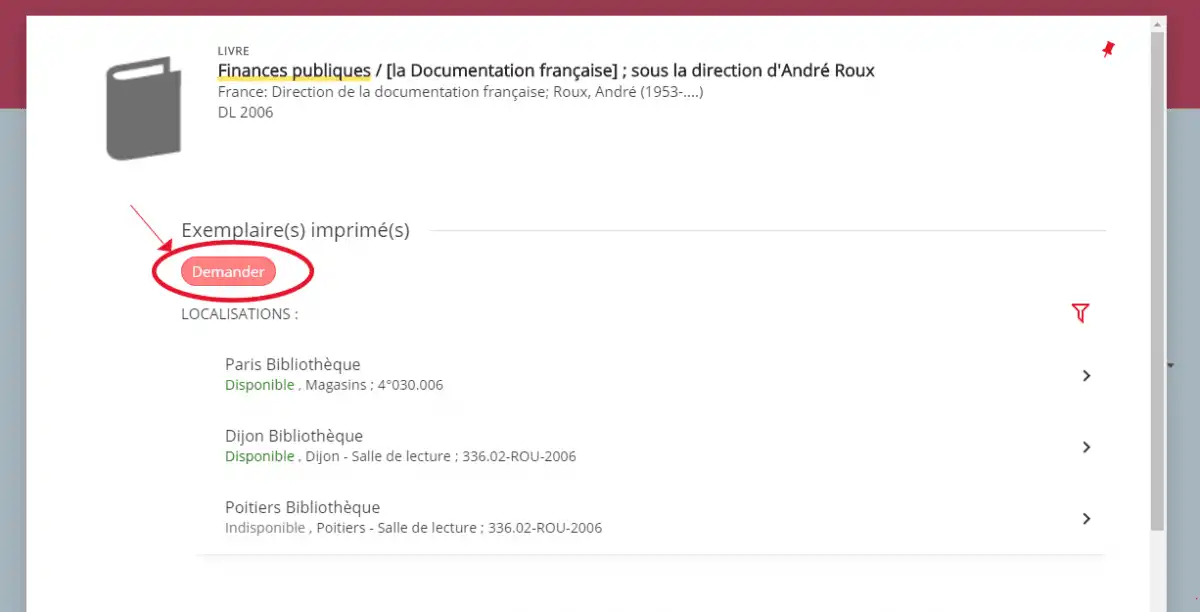
For journals, the Request button appears next to the issue, not the title. You can filter issues according to location, volume, and year, among other things.
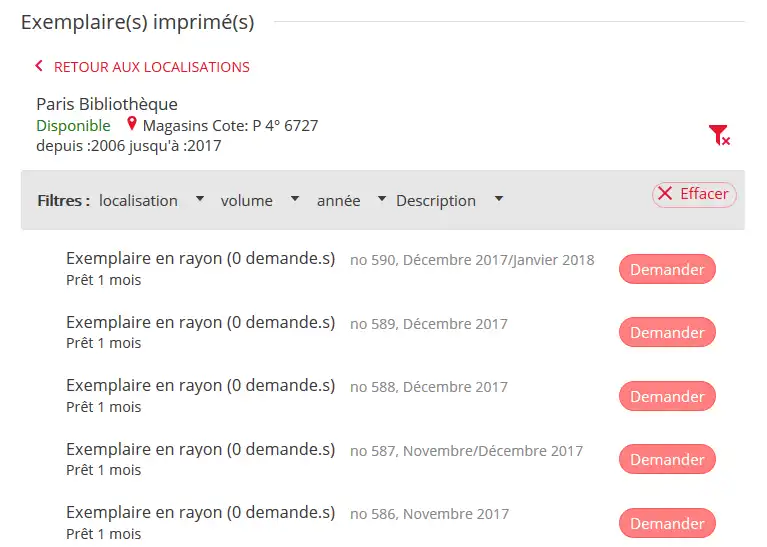
Step 2: The request form appears.
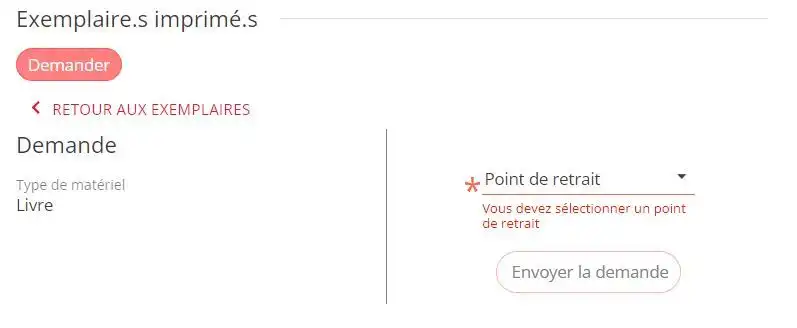
It tells you how long the item can be borrowed for. Now just click Send request.
You can manage your requests from your library account.
You will receive an email when the item is available to collect.
If an item is marked unavailable (because it’s out on loan or in repair, for example), you can use the Request button to reserve the item. You can find out your position in the queue by looking at your library account.
Access an item online
It is important to sign in early on in your search: some of the content and services offered will only be visible once you are signed in.
Following a simple or advanced search, click on a result to see its full description.
The record contains three main sections:
- the location/access section

- the item’s bibliographic record (or details)
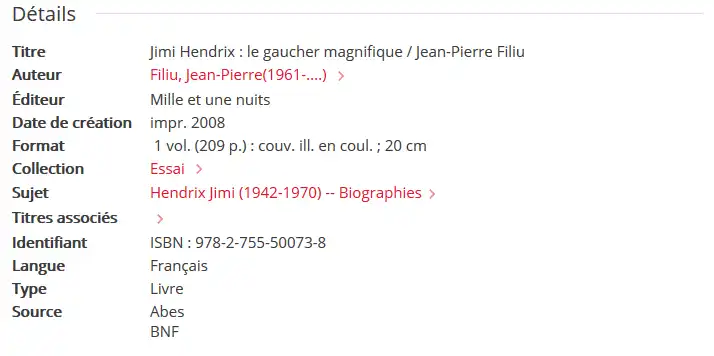
- the Send To section

In the list of results, items accessible in electronic format are marked Available Online.

When you have the item record open, simply click on one of the links offered in the View Online section. If you are on campus, no authentication will be required.
If you are off-campus and a member of the Sciences Po community (more info here), you will need to authenticate to access the content.
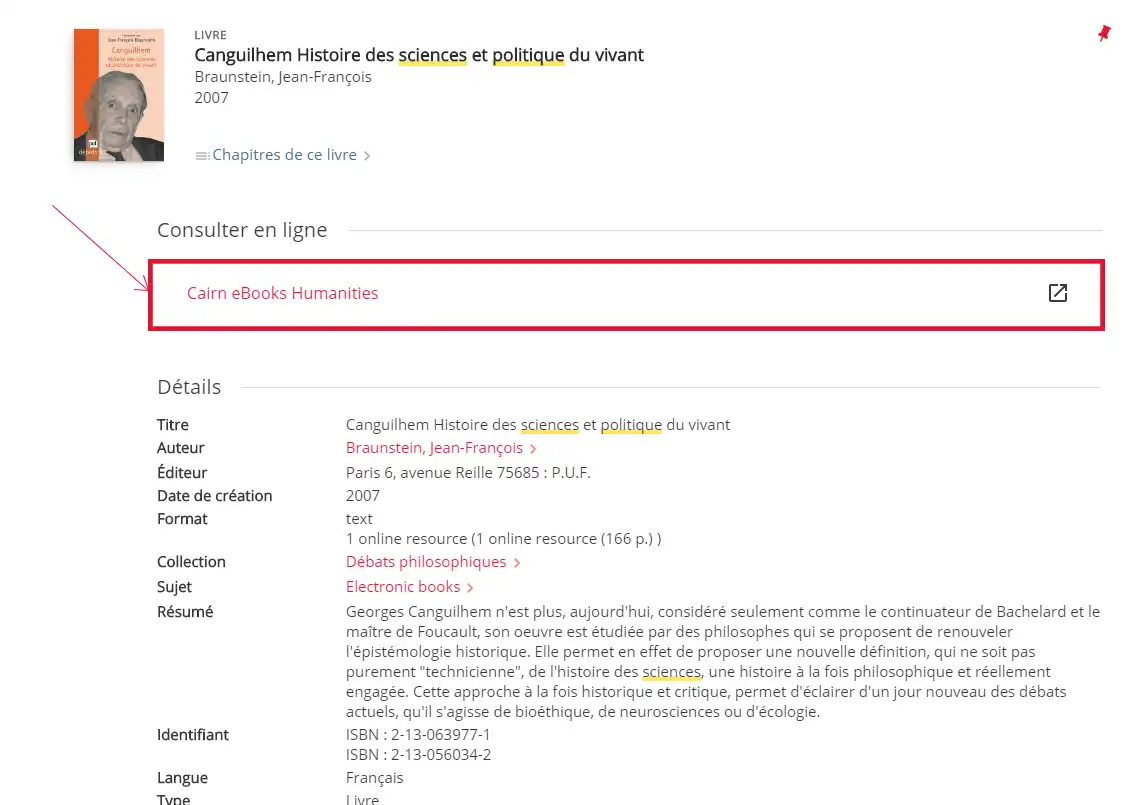
Manage your “favourites”
Step 1: Pin an item as a favourite.
When you are looking at a list of results or an item’s detailed description, you can “pin” an item or items to add them to your favourites. Just click on the red pin icon.
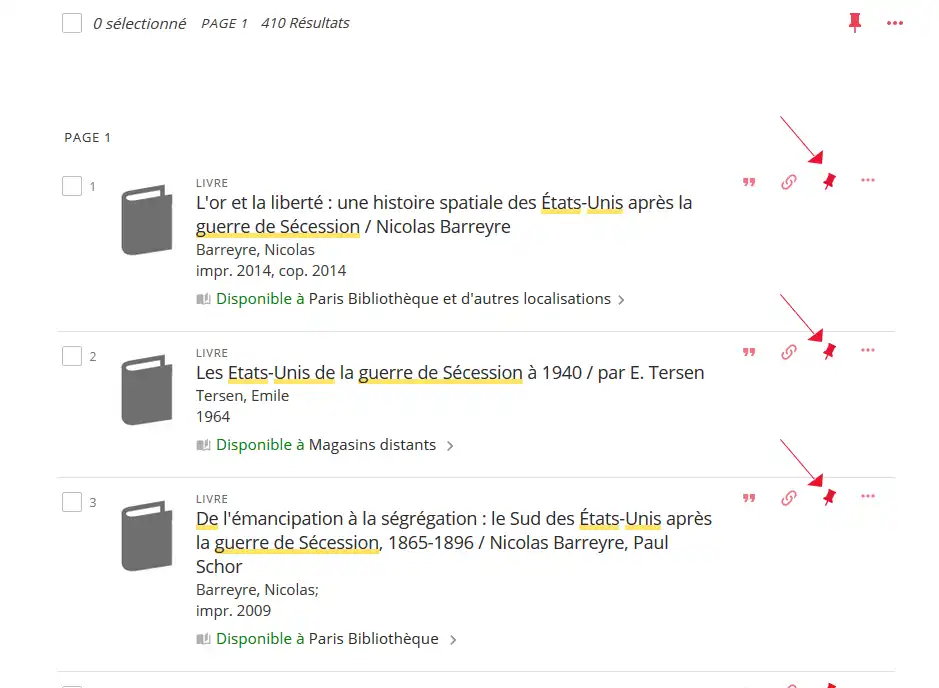
Step 2: Manage your favourites.
To find and manage your favourites, click on the red pin icon in the menu bar at the top of the page. In My Favourites, go to the Saved Records tab.
There you can manage your saved items:
- organise them by adding your own tags;
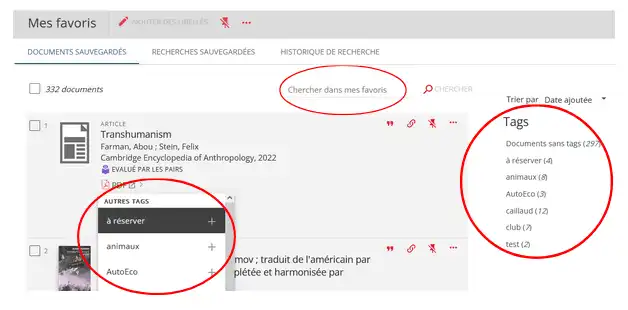
- delete them by clicking on the crossed-out pin by the item.
Saving your searches
In the course of your work, you may have to do the same literature search several times. To avoid starting over each time, you can save searches for future reference and create alerts.
Step 1: Perform a simple or advanced search..
Step 2: Once the list of results is displayed, click Save Query.
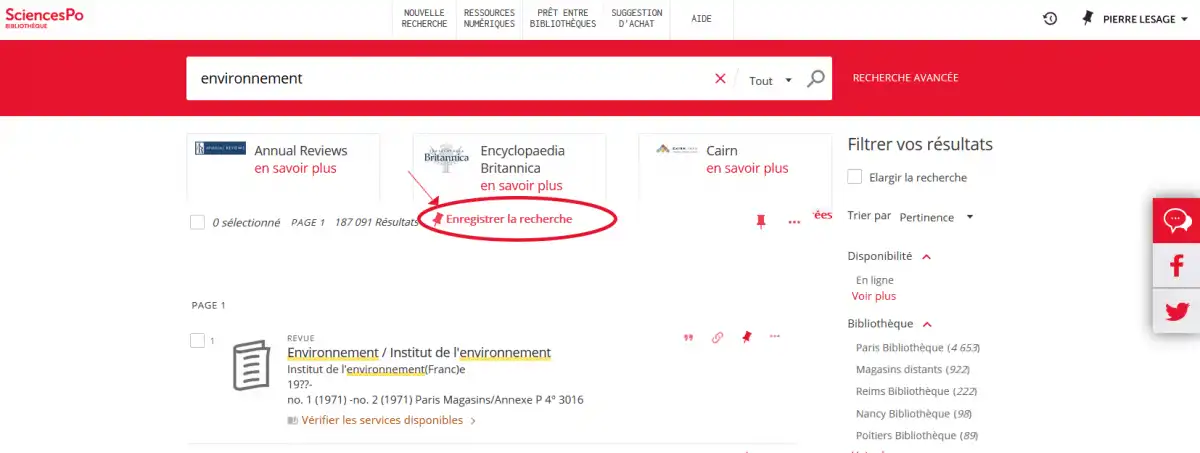
Step 3: to find and manage your saved searches, click on the red pin button in the menu bar at the top of the page. In My Favourites, go to the Saved Searches tab.
Here you will find all your saved searches and can:
- set up an RSS feed for your search
- subscribe to an email alert which will inform you as soon as there is a new result corresponding to your search.
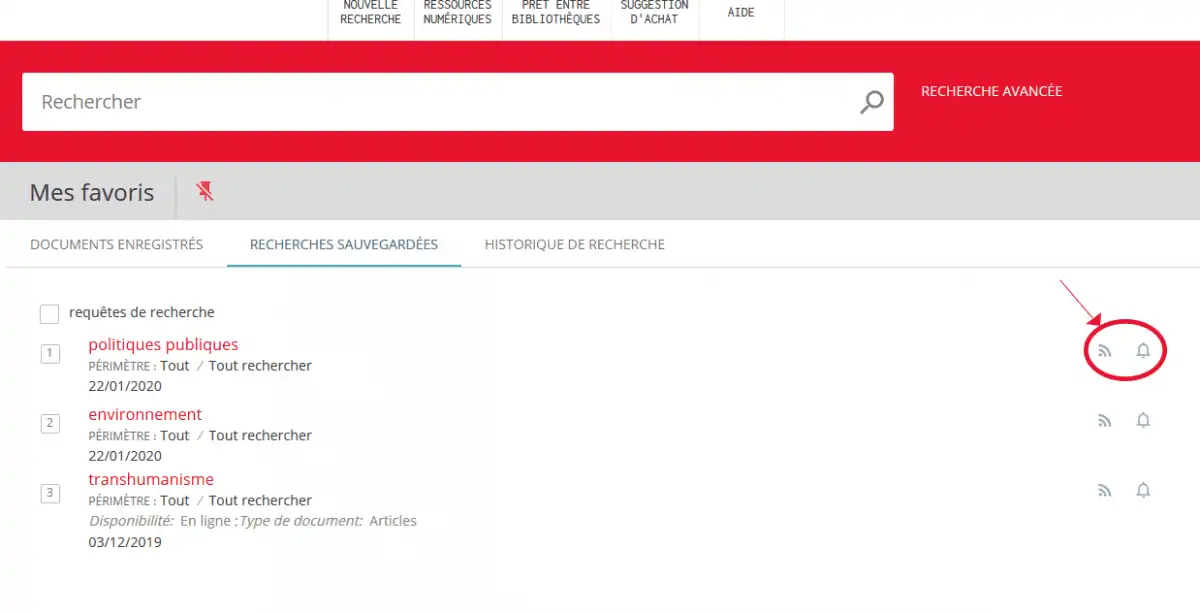
Your library account
It is important to sign in early on in your search: some of the content and services offered will only be visible once you are signed in.
Step 1: When you’re logged in, your name appears at the top right of the screen. Click on your name; then, in the drop-down menu, click on Patron Account.

- Your library account lets you check a number of details:
- Loans
This section shows all items you currently have on loan (and your borrowing history for the past twelve months). This is where you can renew your loans. - Requests
In this section, you can keep track of your requests. The date and place that each item will be made available is displayed. This is where you can cancel a request. - Blocks
This section tells you about blocks on your account, that is, when you can no longer request or borrow (e.g. if you have an item overdue).
You will also find any specific information (Messages) concerning you from library staff (e.g. proxy accounts).
- Loans
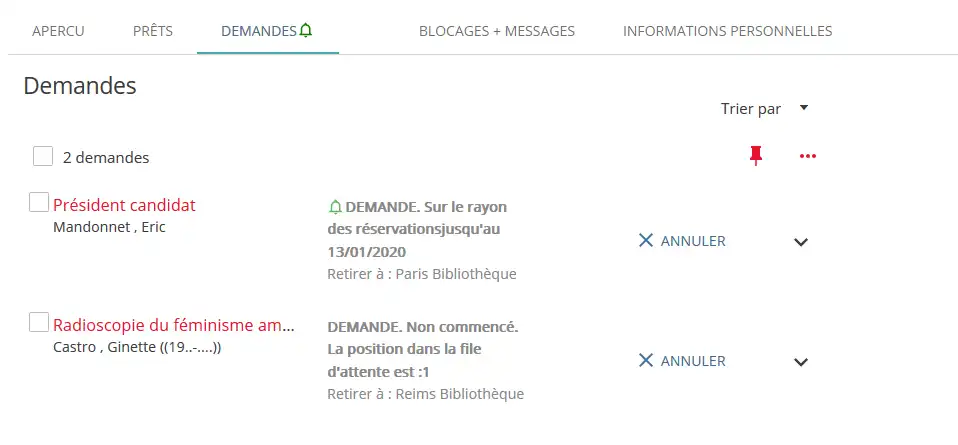
See also the legal notice for the catalogue.
Use the AI search assistant in the catalogue
Watch the video tutorial on YouTube
The AI research assistant in the catalogue aims to provide, following a question formulated in natural language, the five most relevant online academic sources on the subject.
The short answer returned by the assistant is structured and sourced: the relevant sources proposed cannot be fabricated, since queries are sent within a specific scope, namely the library's digital academic resources (Cairn, Wiley, Sage, etc.) already referenced in the catalogue, i.e. nearly 92 million scientific articles / 500,000 books and theses online.
To ensure that your search covers this scope, it is important to select the filter Available at Sciences Po from the outset.

At present, this assistant can only answer questions of a documentary nature within an academic scope: current events are therefore excluded, as are legal and statistical resources. It is neither a writing assistant nor a methodological coach. Printed documentation is also excluded from the system for the time being.
The assistant is a complement to the Catalogue, which in no way exempts users from thoroughly reading the documents recommended by the tool, mastering documentary research and source evaluation techniques, or mentioning its use in accordance with Sciences Po's terms and conditions for generative AI.
You can address the assistant in any language, but the use of English or French is preferable. In all cases, the tool is case-sensitive.
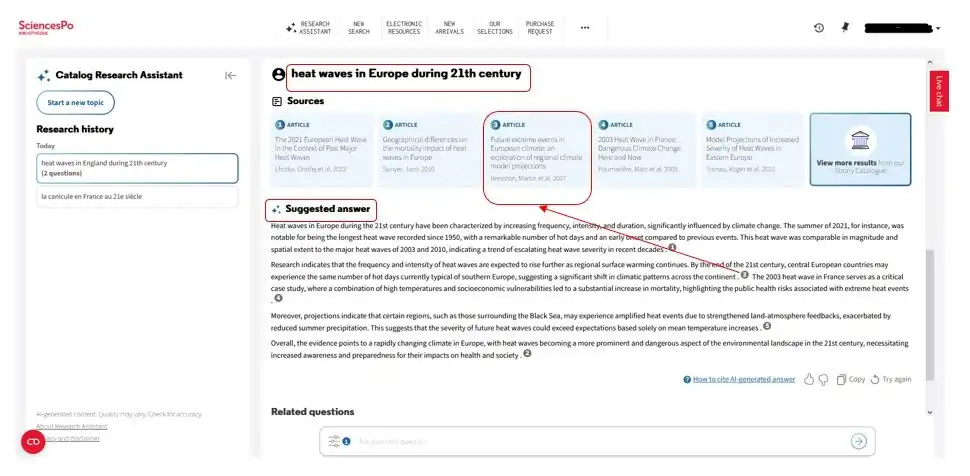
If you have any questions, please do not hesitate to contact resnum.bib@sciencespo.fr.